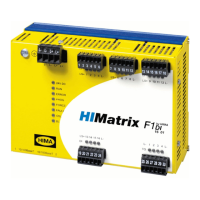HI 800 101 HIMatrix Engineering Manual
3.5 Earth and Shield
3.5.1 Earthing the System Voltage 24 VDC
All devices of the HIMatrix family must be operated with power supply units that comply with
the SELV (Safety Extra Low Voltage) or PELV (Protective Extra Low Voltage) requirements.
A function earth is provided to improve the electromagnetic compatibility (EMC).
All HIMatrix systems can be operated non-earthed or with earthed reference pole L-.
3.5.1.1 Non-earthed Operation
Non-earthed operation offers some advantages in relation to EMC performance.
Some applications make own demands on the non-earthed operation of controllers, e.g. ac-
cording to the standard VDE 0116 an earth fault monitor is required for non-earthed opera-
tion.
3.5.1.2 Earthed Operation
The earth must be designed in accordance to the standard and must have a separate earth
contact through which no power dependent interference current flows. Only the negative po-
le (L-) may be earthed. The positive pole (L+) may not be earthed because every earth fault
on the sensor line would mean that the sensor is short-circuited.
The L- must only be earthed at one point inside the system. The L- is usually earthed directly
behind the power supply unit (e.g. on a bus bar). The earth must be easily accessible and
disconnectable. The earth resistance must be ≤ 2 Ohm.
3.5.2 Earth Connections
All HIMatrix devices have labeled screws for earthing. The core cross section for the connec-
tion to the screw is 2.5 mm
2
. The earth wires must be as short as possible.
If HIMatrix compact devices are mounted on the rail this is already sufficient earth connec-
tion, as long as the rail itself is earthed in accordance to the standard.
These measures will give a reliable earth and will also meet the requirements of the applica-
ble EMC regulations for HIMatrix systems.
3.5.3 Shields
Sensor or actuator lines for analog inputs and outputs of HIMatrix systems with shrouds
(F3 AIO 8/4 01, F35 und F60) must be installed as shielded cables. The shield must be
earthed at one end at the device side, and the case of the sensor or actuator must be con-
nected over a wide area to the cable shield to create a Faraday cage.
The F3 AIO 8/4 01, F35 and F60 have rails at the front conductively connected with the case
potential to earth the cable shield. The cable shield is connected there to the rail with a
clamp.
In all other devices the shield must be positioned in the controller case, terminal cabinet,
control cabinet etc.
17 of 61

